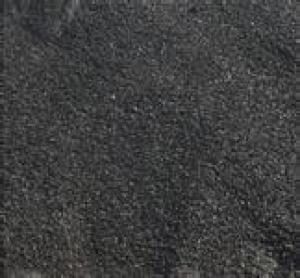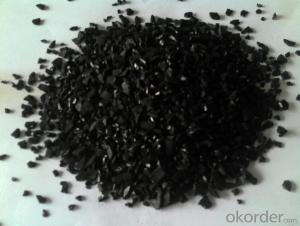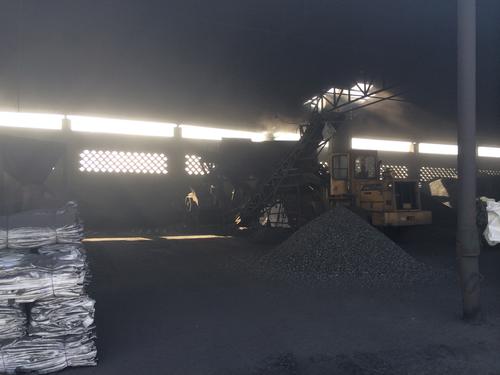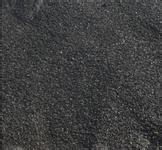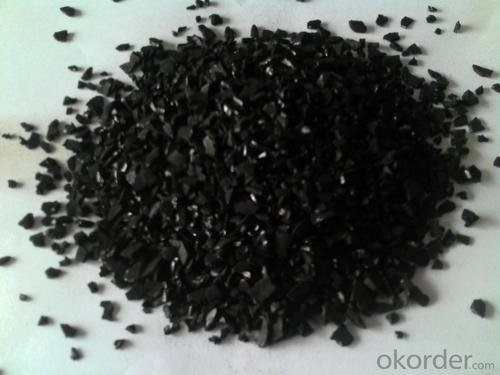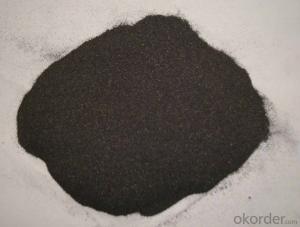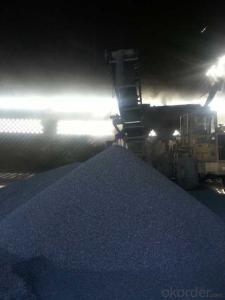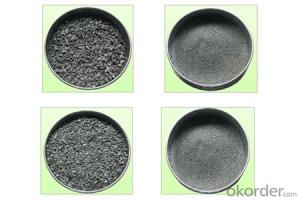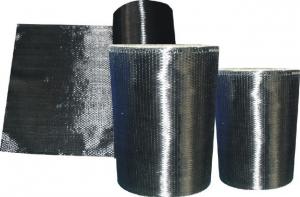Carbon Additive FC 92%/ CNBM Carbon Additive
- Loading Port:
- Tianjin
- Payment Terms:
- TT OR LC
- Min Order Qty:
- 0 m.t.
- Supply Capability:
- 100000 m.t./month
OKorder Service Pledge
OKorder Financial Service
You Might Also Like
Product Description
Carbon additive (carbon raiser) with characteristic of low ash and low sulfur is made from calcined petroleum coke, graphite petroleum coke or high quality anthracite coal . As an ideal recarburizer and intermediate reactor, it has been widely used in different industries like metallurgy, chemistry, machinery, electricity, etc.
The selection of a charging carbon is determined by the quality requirements of the steel or ferroalloy production as well as the cost and availability of carbon products. So the recarburizer is mainly used in the metallurgy to increase the content of carbon.
Packaging & Delivery
| Packaging Details: | 1. carbon additive in 1 MT jumbo bag 2. carbon additive in 25kg PP bag 3. carbon additive in 50 kg woven bag 4. carbon additive in bags then put them on pallet 5.bulk in container 6.as your requirements |
| Delivery Detail: | within 10 days after receiving 30% deposit or LC |
Specification
Carbon | Min98% |
Ash | Max0.5% |
Sulphur | Max0.05% |
V.M | Max0.5% |
Moisture | Max0.5% |
N | Max0.03% |
H | Max0.01% |
Sizes(mm) | 1-5 1-3 3-10 1-10 |
Calcined petroleum coke as carbon additive
Carbon | Min89% |
Ash | Max0.3% |
Sulphur | Max6% |
V.M | Max10% |
Moisture | Max8% |
N | Max0.03% |
H | Max0.01% |
Sizes(mm) | 1-5 3-8 5-15 10-20 |
Calcined anthracite coal as carbon additive
Carbon | Min90-95% |
Ash | Max5% |
Sulphur | Max0.5% |
V.M | Max1.5% |
Moisture | Max0.5% |
N | Max0.03% |
H | Max0.01% |
Sizes(mm) | 1-5 3-8 1-3 |
Pictures of Calcined AnthraciteCoal
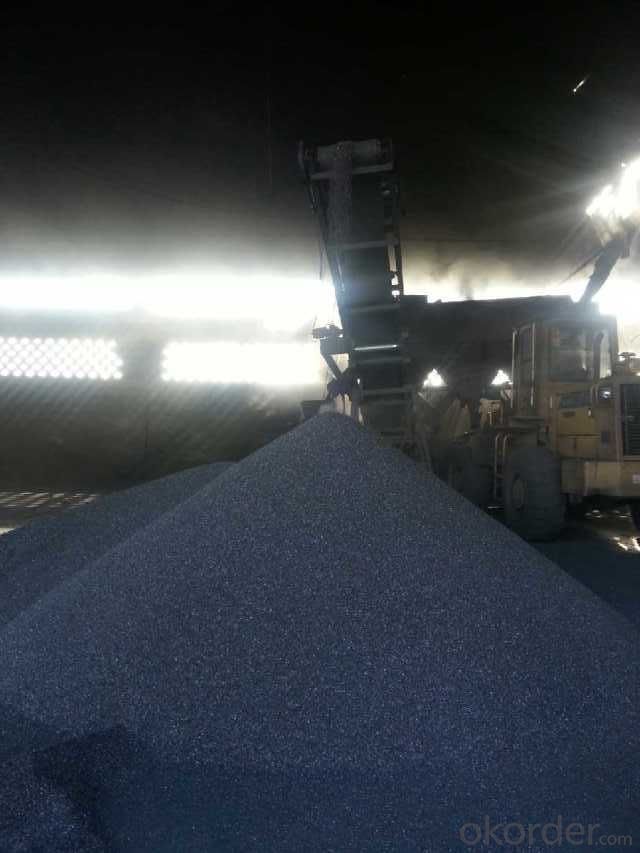
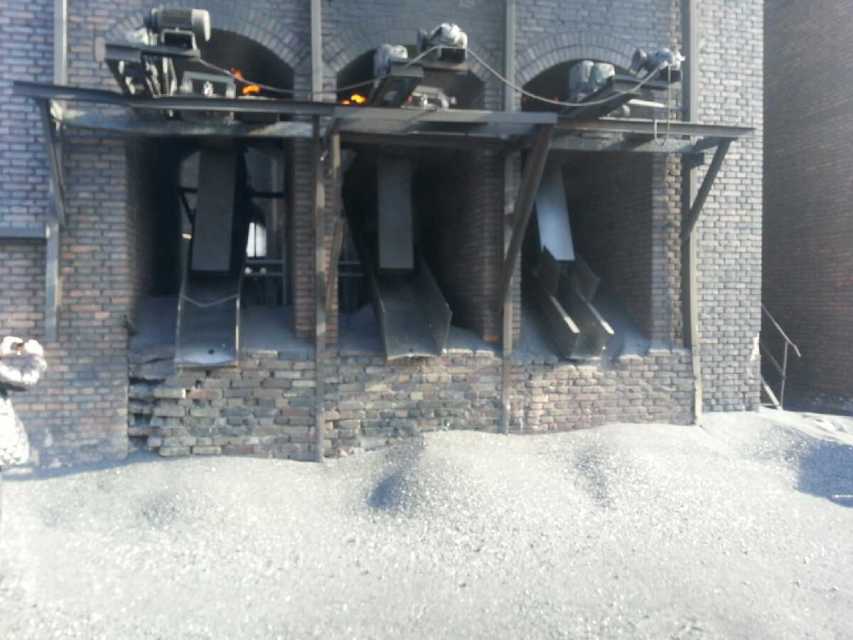
- Q: What are the impacts of carbon emissions on the stability of savannas?
- Carbon emissions have significant impacts on the stability of savannas, which are delicate and diverse ecosystems. One of the main consequences of carbon emissions is the increase in greenhouse gases, such as carbon dioxide, in the atmosphere. This leads to global warming, which has several direct and indirect effects on savannas. Firstly, higher temperatures resulting from global warming can alter the natural fire regimes in savannas. These ecosystems are adapted to periodic fires, which play a crucial role in maintaining their structure and biodiversity. However, increased temperatures can intensify and prolong fire seasons, leading to more frequent and intense wildfires. This can disrupt the natural balance, causing the loss of vegetation, changes in species composition, and reducing the overall stability of the savanna ecosystem. Secondly, elevated carbon dioxide levels can affect the physiology and growth of plants. While some studies suggest that increased CO2 concentrations may enhance plant productivity in savannas, it is important to consider other factors such as nutrient availability and water availability. If these factors do not keep pace with increased carbon dioxide levels, the positive effects on plant growth may be limited, leading to imbalances in the ecosystem. Furthermore, carbon emissions contribute to climate change, which alters rainfall patterns and distribution. Savannas rely on a delicate balance between wet and dry seasons. Changes in precipitation patterns can disrupt this balance, affecting the availability of water for plants and animals. This can lead to shifts in species distribution, reduced habitat suitability, and increased competition for limited resources, further destabilizing the savanna ecosystem. Lastly, carbon emissions also contribute to ocean acidification, which affects marine ecosystems. Coral reefs, which are interconnected with savannas through coastal regions, provide essential habitat and protection for many marine species. Acidic waters can harm coral reefs, leading to their decline and subsequent loss of biodiversity in savanna ecosystems. In conclusion, carbon emissions have significant impacts on the stability of savannas. Global warming, changes in fire regimes, altered precipitation patterns, and ocean acidification all affect the delicate balance and biodiversity of these ecosystems. It is crucial to address carbon emissions and mitigate their effects to ensure the long-term stability and conservation of savannas and the services they provide.
- Q: What is carbon emission and what harm does it do? How can carbon dioxide be prevented?
- Carbon deposition reaction:CH4 = kJ/mol C+H274.92CO = CO2+C +172.4 kJ/mol on.The main cause of carbon analysis is that the ratio of water to carbon is too low, so that the rate of carbon removal is lower than the rate of carbon depositionThe above chemical reactions are reversible reaction, from the analysis of thermodynamics, if the increase in temperature or reducing system pressure, increase the possibility of methane decomposition reaction type is CH4 C+H2 produce coke; possibility of CO reaction 2CO = CO2+C and CO = C + H2 reaction +H2O produce coke decrease. If the temperature is reduced or increased the pressure is on the contrary. The effect of temperature on coke reaction is very large, to avoid the [wiki] [/wiki] carbon catalyst must select the appropriate temperature, avoid carbon deposition area.
- Q: What are the challenges and opportunities of transitioning to a low-carbon economy?
- Transitioning to a low-carbon economy presents both challenges and opportunities. On the one hand, one of the major challenges is the need for significant changes in infrastructure, technology, and behavior. This transition requires substantial investments in renewable energy sources, energy-efficient buildings, and sustainable transportation systems. It also entails a shift away from fossil fuels, which have been deeply embedded in our economies for centuries. Another challenge is the potential economic impact on industries that heavily rely on carbon-intensive activities. Sectors such as coal mining, oil refining, and traditional manufacturing may face job losses and economic disruptions. The transition will require careful planning and support to ensure a just and inclusive transition for affected workers and communities. However, transitioning to a low-carbon economy also offers numerous opportunities. Firstly, it can spur innovation and create new industries and job opportunities. The development and deployment of renewable energy technologies, such as solar and wind power, can foster economic growth and provide employment in manufacturing, installation, and maintenance. It also promotes research and development in clean technologies, leading to breakthroughs and discoveries that can benefit various sectors. Secondly, transitioning to a low-carbon economy can improve public health and quality of life. By reducing reliance on fossil fuels, we can mitigate air pollution and its related health issues, such as respiratory problems and cardiovascular diseases. Additionally, investments in energy-efficient buildings can enhance comfort, reduce energy costs, and improve indoor air quality. Furthermore, transitioning to a low-carbon economy can enhance energy security and reduce geopolitical tensions. By diversifying energy sources and reducing dependence on fossil fuel imports, countries can increase their resilience to price fluctuations and geopolitical conflicts. This shift also promotes energy independence and reduces the need for costly military interventions in resource-rich regions. Lastly, transitioning to a low-carbon economy is essential for combating climate change and protecting the environment. By reducing greenhouse gas emissions, we can mitigate the impacts of global warming, such as extreme weather events, rising sea levels, and ecosystem disruptions. This transition allows us to preserve biodiversity, protect natural resources, and create a sustainable future for future generations. In conclusion, transitioning to a low-carbon economy brings challenges, including infrastructure changes, economic disruptions, and job losses. However, it also presents opportunities for innovation, job creation, improved public health, enhanced energy security, and environmental protection. With careful planning, collaboration, and support, the challenges can be overcome, and the opportunities can be maximized, leading to a more sustainable and prosperous future.
- Q: What are the impacts of carbon emissions on glacier retreat?
- Glacier retreat is significantly affected by carbon emissions. Human activities, such as burning fossil fuels and deforestation, release carbon dioxide and other greenhouse gases into the atmosphere, contributing to global warming. This rise in global temperatures directly affects glaciers. Glaciers are massive ice bodies that form over long periods from accumulated snowfall. They serve as natural freshwater reservoirs, providing an essential source of drinking water to millions of people worldwide. However, as carbon emissions cause the Earth's temperature to increase, glaciers melt at a faster rate. The warming climate causes glaciers to lose more ice through melting than they gain through snowfall. This results in a net ice loss, leading to glacier retreat. As glaciers retreat, they not only decrease in size but also become thinner. This reduces their water storage capacity, impacting water availability in regions that rely on glacial meltwater for drinking, irrigation, and hydropower. Moreover, glacier retreat has extensive implications for ecosystems and biodiversity. Glaciers offer unique habitats for various species, including plants, animals, and microorganisms that have adapted to survive in extreme environments. As glaciers vanish, these species must adapt or relocate to other areas, disrupting ecosystem equilibrium. The consequences of glacier retreat extend beyond local and regional scales. Glacial meltwater contributes to rivers and lakes, ensuring a consistent water flow throughout the year. As glaciers shrink, this flow diminishes, leading to water scarcity during dry periods. This poses a threat to agriculture, urban water supplies, and the overall sustainability of ecosystems reliant on stable water sources. Additionally, glacier loss contributes to rising sea levels. When glaciers melt, the water they release flows into the oceans, causing them to expand. This worsens coastal erosion, increases the risk of flooding in low-lying areas, and endangers coastal communities and infrastructure. In conclusion, carbon emissions profoundly impact glacier retreat. The resulting global warming accelerates glacier melting, leading to water scarcity, loss of biodiversity, rising sea levels, and various environmental and socio-economic consequences. It is crucial to address carbon emissions and take action to mitigate climate change in order to preserve these crucial ice formations and the ecosystems and communities that depend on them.
- Q: What are the properties of carbon fibers?
- Carbon fibers are known for their exceptional strength and stiffness, making them ideal for applications requiring high-performance materials. They possess a low density, corrosion resistance, and excellent thermal conductivity. Additionally, carbon fibers exhibit high resistance to fatigue and have a high tensile strength, allowing them to withstand extreme conditions. They are also chemically inert and have a low coefficient of thermal expansion, making them versatile for various industries such as aerospace, automotive, and sports equipment.
- Q: What are carbon sinks?
- Carbon sinks are natural or artificial reservoirs that absorb and store carbon dioxide from the atmosphere. They play a crucial role in mitigating climate change by reducing the concentration of greenhouse gases in the atmosphere. Carbon sinks can be found in various forms, including forests, oceans, wetlands, and soil. Forests are the largest and most well-known carbon sinks. Through the process of photosynthesis, trees absorb carbon dioxide and convert it into oxygen, storing the carbon in their trunks, branches, and roots. Oceans are also significant carbon sinks, as they absorb about a quarter of the carbon dioxide emitted by human activities. Algae, phytoplankton, and other marine organisms capture carbon through photosynthesis and convert it into biomass. Wetlands, such as marshes and swamps, are another important carbon sink. These areas store enormous amounts of carbon in their vegetation and soil, preventing it from being released back into the atmosphere. Additionally, soil acts as a carbon sink by absorbing and storing carbon through the decomposition of organic matter and the action of microorganisms. Artificial carbon sinks, like carbon capture and storage (CCS) technologies, are being developed to further combat climate change. CCS involves capturing carbon dioxide emissions from power plants and industrial facilities and storing them underground or repurposing them for other uses. While these technologies are still in the early stages, they have the potential to significantly reduce carbon emissions and help stabilize the climate. Overall, carbon sinks are essential for maintaining the balance of carbon dioxide in the atmosphere and preventing its accumulation, which would contribute to global warming. Preserving and restoring natural carbon sinks, such as forests and wetlands, is crucial for mitigating climate change, while developing and implementing artificial carbon sinks can further aid in reducing greenhouse gas emissions.
- Q: How is carbon used in the manufacturing of electronics?
- Carbon is used in several ways in the manufacturing of electronics. One of the primary uses of carbon in electronics is as a key component in the production of carbon nanotubes. These nanotubes have exceptional electrical conductivity and mechanical strength, making them ideal for use in various electronic devices. For instance, carbon nanotubes can be used to create high-performance transistors, which are essential components in computer chips. Additionally, carbon is utilized in the manufacturing of batteries for electronic devices. Carbon-based materials, such as graphite, are commonly used as the anode material in lithium-ion batteries. This is because graphite can store and release lithium ions efficiently, allowing for the rechargeable nature of these batteries. Furthermore, carbon is employed in the production of conductive coatings and inks used for printed circuit boards (PCBs). Carbon-based materials, such as carbon black or carbon nanotubes, are added to these coatings and inks to enhance their electrical conductivity. This enables the proper flow of electrical signals throughout the circuitry of electronic devices. In summary, carbon plays a crucial role in the manufacturing of electronics. It is used in the production of carbon nanotubes for high-performance transistors, as anode material in lithium-ion batteries, and in conductive coatings and inks for printed circuit boards. These applications highlight the versatility and importance of carbon in the electronics industry.
- Q: What are the consequences of increased carbon emissions on forest ecosystems?
- Increased carbon emissions have a range of negative consequences on forest ecosystems. Firstly, higher levels of carbon dioxide in the atmosphere contribute to global warming, leading to higher temperatures and altered precipitation patterns, which can negatively impact the growth and health of forest plants. Additionally, increased carbon dioxide levels can stimulate the growth of invasive plant species, leading to competition and reduced biodiversity. Moreover, carbon emissions contribute to ocean acidification, which can harm marine ecosystems that are interconnected with forests. Lastly, increased carbon emissions can intensify the frequency and severity of wildfires, posing a significant threat to forest ecosystems and their ability to regenerate.
- Q: Is the power consumption of carbon fiber heating very high?
- Power consumption calculation:The information you give is not enough to calculate the approximate power consumption!You also need to know your building structure, insulation level, the laying power of electric heating, personal use, setting temperature, local temperature difference between indoor and outdoor, control device is intelligent temperature control and so on!There is also the first heating season, because the building is humid, the electricity consumption will be higher!How to save electric energyIf you want to save electricity, you need it:Give the building a good heat insulation,Use double or three layers of glass,Intelligent temperature controller, and according to the rules of personal life to set, make full use of energy saving, and these are not to reduce somatosensory comfort conditions,The carbon fiber heating cable laying and electric heating, far infrared ray to human body temperature will be higher, also need 18 degrees of comfort, the use of carbon fiber electric heating heating cable only need to set at 16 degrees, so the temperature can be, 2 DEG C, and the temperature difference is small at the only Province 2 C energy, in fact is not the case, as we all know, small temperature difference, the indoor temperature is more easy to maintain!Apply the peak and valley tariff to the local electricity department, so that the electricity price will be around 0.35 yuan at night, and the temperature will be greater at home and in the evening, which will save a lot of money!Do all of this and I'm sure you'll save 20% of your electricity bill!Poly Jiao carbon fiber heating cable electric heating - for you, we are more professional
- Q: How is carbon dioxide released into the atmosphere?
- Carbon dioxide is emitted into the atmosphere due to a range of natural and human activities. The burning of fossil fuels, like coal, oil, and natural gas, for energy generation is one of the main sources of carbon dioxide. Combustion of these fuels releases carbon dioxide as a byproduct, which occurs in power plants, factories, and vehicles that rely on fossil fuels for energy. Deforestation and changes in land use also contribute to the release of carbon dioxide into the atmosphere. Through photosynthesis, trees absorb carbon dioxide, and when they are cut down or burned, the stored carbon is released back into the atmosphere. This is especially significant in tropical rainforests, which store large amounts of carbon in their vegetation. Furthermore, natural processes like respiration and volcanic eruptions release carbon dioxide into the atmosphere. In respiration, living organisms, including humans and animals, take in oxygen and exhale carbon dioxide as a waste product. Volcanic eruptions release carbon dioxide that was stored in magma and rock formations. In general, the release of carbon dioxide into the atmosphere is a combination of natural and human activities. However, human activities, particularly the burning of fossil fuels and deforestation, have significantly raised the levels of carbon dioxide in the atmosphere, resulting in the greenhouse effect and climate change.
Send your message to us
Carbon Additive FC 92%/ CNBM Carbon Additive
- Loading Port:
- Tianjin
- Payment Terms:
- TT OR LC
- Min Order Qty:
- 0 m.t.
- Supply Capability:
- 100000 m.t./month
OKorder Service Pledge
OKorder Financial Service
Similar products
Hot products
Hot Searches
Related keywords

